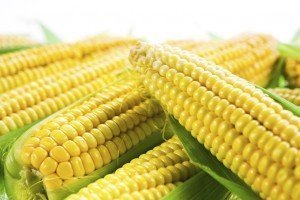
Preserving Corn and Other August Gardening Tips
Charlie Nardozzi, Horticulturist and
Leonard Perry, UVM Extension Horticulturist
 Preserving corn, freezing berries, and making pesto from basil, are some of the gardening activities for this month.
Preserving corn, freezing berries, and making pesto from basil, are some of the gardening activities for this month.
Preserve the fresh-picked (well, almost) flavor of corn on the cob for winter meals. Cook the cobs as usual, then using a special corn scraper or a sharp knife, cut off the kernels and freeze them in freezer bags. They will be much tastier than any store-bought frozen or canned corn.
Berries such as blueberries, raspberries, and blackberries are easy to freeze for smoothies over the coming months. Rinse the berries and let them dry on paper towels. Spread them in a single layer in cake pans or whatever size pans will fit in your freezer. When frozen, pour them into labeled freezer bags or plastic containers, and pop them back in the freezer. If you just put them in bags or containers and freeze there first, they stick together into a hard clump.
When harvesting basil, instead of just removing individual leaves, cut back whole side stems (but not the whole plant or main stems). This will create a bushier plant that will produce more leaves subsequently, and less flowers and scraggly growth. Pick basil in the morning for the best flavor. This is when the oil content in the leaves is highest.
Even if you didn’t grow basil this year, you can buy bunches at farmer’s markets and farm stands. Use the leaves to dry for seasoning later, or cook into pesto you can freeze for the coming year (or even longer). Soup with vegetable broth, sugar pea pods, tortellini and pesto is an easy, healthful, flavorful and welcome meal, particularly in winter or cool days of fall.
Once you harvest crops, build the nutrient levels and organic matter in garden beds by sowing cover crops like annual ryegrass or buckwheat into empty annual beds. They will grow until winter kills them and then can be incorporated into the soil in spring. Cut down buckwheat before it flowers so seeds don’t become a problem.
After a few days without rain, take a hose to the compost pile and moisten the materials to keep them decomposing. Use a compost fork to mix the ingredients, moving the stuff around the outside of the pile into the middle where most of the decomposition takes place.
Take cuttings of favorite geraniums, coleus, begonias, and any other annual flowers that you want to grow again next summer. Also, you can bring these plants indoors for the winter if you have a sunny spot. Several popular bedding plants are perennial in warm climates and can be brought indoors as houseplants if you don’t wait until the weather gets too cool, which can set them back and make it hard for them to recover. Gradually move the plants into shadier locations so they are better adjusted to the reduced light levels when you move them indoors.
You should have stopped pruning most trees and shrubs by now. Pruning woody plants stimulates new growth that may not have time to harden off before the first cold snap of autumn. Allow roses to form hips. Leaving spent rose flowers so they form hips signals roses that they, too, should begin winding down.
Other gardening activities for this month include lining up a plant sitter for vacations (group plants in pots to make their job easier, or move into shade for less watering), removing garlic stalks once dried and storing in a dry and well-ventilated space, mowing less and higher if grass isn’t growing, and visiting nurseries to pick up some late season blooming perennials (like Joe Pye, Helen’s flower, tall garden phlox, cimicifuga, sedum, Russian sage, and asters).
Explore Communities with Community Gardens
Receive your complimentary Relocation guide and magazine

